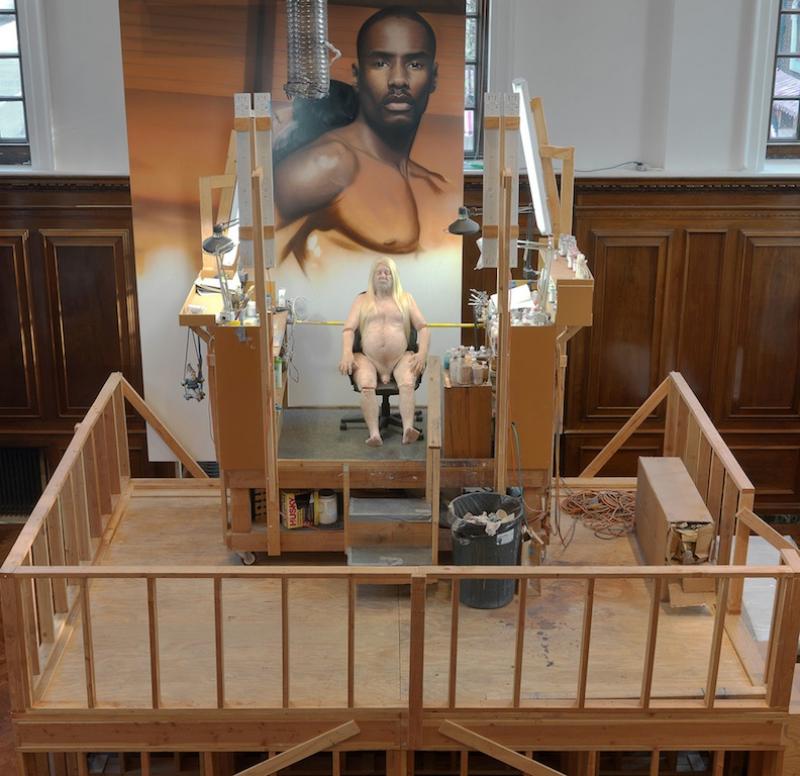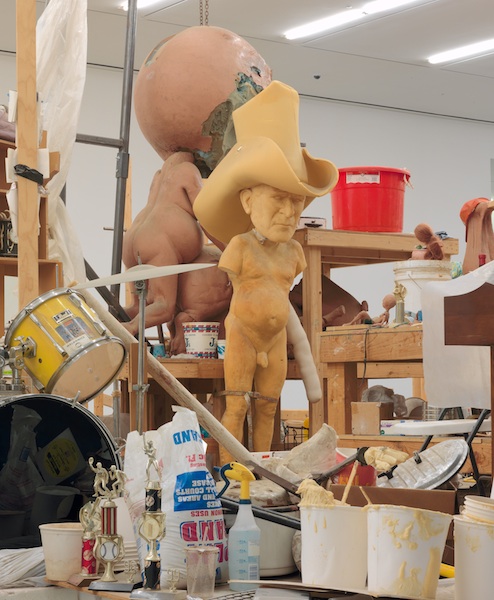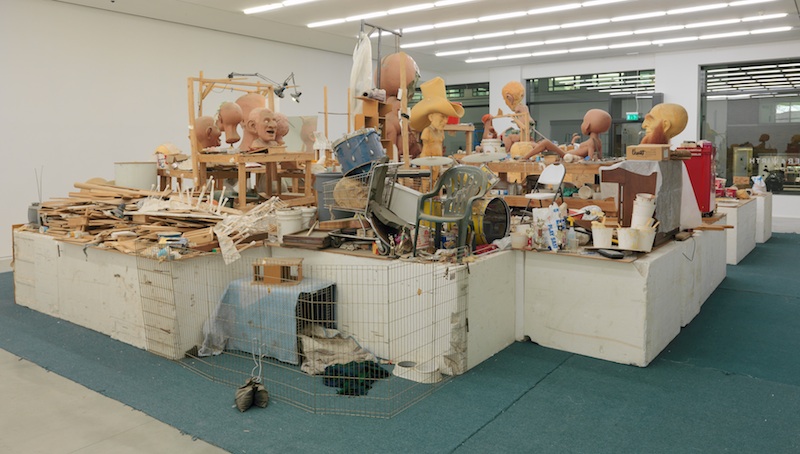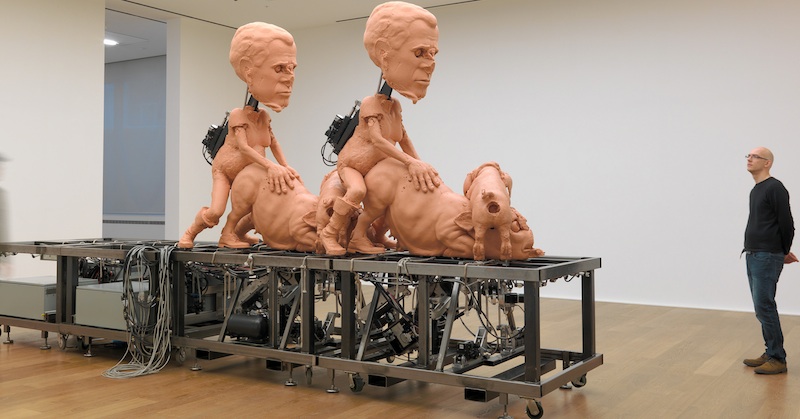Paul McCarthy: The King, The Island, The Train, The House, The Ship, Hauser & Wirth | reviews, news & interviews
Paul McCarthy: The King, The Island, The Train, The House, The Ship, Hauser & Wirth
Paul McCarthy: The King, The Island, The Train, The House, The Ship, Hauser & Wirth
From chainsaw violence to sex with sows, is this West Coast artist funny or flagrantly vile?

Until recently, on YouTube, you could watch Paul McCarthy and Mike Kelley’s Heidi (1992), one of the funniest and most transgressive videos ever made. In a Swiss chalet, the children Heidi and Peter are being “educated” by their abusive grandfather, who freely indulges his propensity for bestiality, incest, onanism and scopophilia.
Hauser & Wirth’s gallery in Piccadilly has been turned into a church. Rows of pews face an elevated throne where the West Coast artist sits holding court; or, rather, a rubber facsimile of his naked self sits on a crummy office chair surrounded by pots of paint – the artist as guru. It is not a pretty sight; his middle-aged paunch protrudes over distended testacles, his face is pock-marked and he wears a long blond wig better suited to Gandalf or the Wizard of Oz than the leader of a religious cult.
 Although presiding over an imaginary flock, the figure does not return our gaze; eyes tight shut, he seems in a trance. Perhaps he is channelling the pictures of chiselled dudes and beautiful babes hung on the surrounding walls. Culled from adverts and glossy magazines, they exemplify the good life that we are meant to aspire to; airbrushed onto large canvases, the images are as slick and blandly desirable as a Jeff Koons. Has McCarthy, purveyor of all things abject and disgusting, flipped over to join the opposite camp – of artists in the business of making seductive commodities?
Although presiding over an imaginary flock, the figure does not return our gaze; eyes tight shut, he seems in a trance. Perhaps he is channelling the pictures of chiselled dudes and beautiful babes hung on the surrounding walls. Culled from adverts and glossy magazines, they exemplify the good life that we are meant to aspire to; airbrushed onto large canvases, the images are as slick and blandly desirable as a Jeff Koons. Has McCarthy, purveyor of all things abject and disgusting, flipped over to join the opposite camp – of artists in the business of making seductive commodities?
Down in the vaults, all becomes clear. Projected onto one wall is a rapid-fire succession of adverts promoting drinks, cars and cigarettes; collectively they build a picture of the American Dream as lived by bikini-clad lovelies and hip young hunks who enjoy perfect health in perpetual sunshine. This relentless bombardment of youthful wellbeing is enough to make anyone feel old, fat, ugly or unfulfilled and impel you to reach for any product promising release from your evident failings. The motor that drives capitalism is not desire so much as self-loathing – fear of falling short of the ideal.
In the next room is Cut-Up, a video of McCarthy assaulting his silicone facsimile with an electric saw. The dummy lies on its back, arms and legs rigidly outstretched; in order to make it sit in a chair, the legs will have to be sliced off at the hip and segments of “flesh” cut away from behind the knees and elbows so the limbs can bend. In one sense, the video is a simple record of studio activity, but given that video has long been central to McCarthy’s practice, it can also be seen as a piece of video art.
Watching the artist attack the hapless figure reminds me of another McCarthy video shown in the same space nine years ago. I recall a performer wearing a George Bush mask being attacked by two others masquerading as the Queen Mother; assaulting their victim with chainsaws, they inflict hideous wounds.
 Unlike the previous video, though, Cut-Up is not a black comedy; fake gore does not gush from prosthetic limbs and the narrative is not one of moral depravity and the abnegation of responsibility. The body being dismembered is, by proxy, his own and watching him saw round the sagging scrotum and slice through the soggy buttocks before standing back to assess the effects of this self-inflicted violence is extremely moving. Rather than escaping into the realms of aspirational desire or sordid make-believe, in this gallery the artist chooses to confront reality.
Unlike the previous video, though, Cut-Up is not a black comedy; fake gore does not gush from prosthetic limbs and the narrative is not one of moral depravity and the abnegation of responsibility. The body being dismembered is, by proxy, his own and watching him saw round the sagging scrotum and slice through the soggy buttocks before standing back to assess the effects of this self-inflicted violence is extremely moving. Rather than escaping into the realms of aspirational desire or sordid make-believe, in this gallery the artist chooses to confront reality.
In Puppet various George Bush figurines are mired in pools of shiny muck that seeps from excitable groins to embody bad intentions
In Hauser & Wirth, Savile Row, though, we return to the realms of depravity and disenchantment. Filling one gallery is Pig Island (pictured above and detail above right), a ramshackle installation elevated on polystyrene blocks and surrounded by a sea of drab blue carpet, which you have to view from stepladders. Accumulated over seven years, this dusty assortment of studio clutter is the arena in which numerous figures of George Bush and Angelina Jolie took shape. A drum kit and piano have joined a shopping trolley, plastic chair, filing cabinets, trestle tables, cardboard tubes, boxes of latex gloves, brushes, tins of glue and resin and buckets of fast food. Part documentary, part installation, the piece sits between two genres, but unlike Cut-Up, gains little from the ambiguity except to stress that there’s not much mystique to art-making.
In the second space, George Bush reigns supreme. In Train (pictured below), his animatronic double has been cloned to produce monstrous twins; as they each sodomise a sow, their mouths drop open, eyeballs roll, heads swivel and hips lunge in synchronised, robotic transport. Made of the same pink substance, man and beast are both swine, it seems. Nothing is left to the imagination; the message is obvious and the mechanism clearly visible.
 You might find this blunt delivery shockingly funny, but for me the sculpture is as kitsch as Jeff Koons’s Pink Panther (1988), a life-sized porcelain of a Jane Mansfield blonde cuddling a perplexed big cat. If Koons explores the beauty of banal popular stereotypes, McCarthy exposes the flip-side – the seduction and banality of evil. If Koons’s message is that low-brow culture is OK, McCarthy’s might be that all sexual fantasies can be accommodated.
You might find this blunt delivery shockingly funny, but for me the sculpture is as kitsch as Jeff Koons’s Pink Panther (1988), a life-sized porcelain of a Jane Mansfield blonde cuddling a perplexed big cat. If Koons explores the beauty of banal popular stereotypes, McCarthy exposes the flip-side – the seduction and banality of evil. If Koons’s message is that low-brow culture is OK, McCarthy’s might be that all sexual fantasies can be accommodated.
Both artists evoke sticky substances. Koons ensnares you in a sugar-coated web of sexualised sentiment and McCarthy sploshes actual goo like ketchup, liquid chocolate, resin and expanding foam over video sets and sculptures. Joined together by steel rods rammed through eye sockets and brains, in Puppet various George Bush figurines are mired in pools of shiny muck that seeps from excitable groins to embody bad intentions. The heavy-handed metaphor of Train gives way to something altogether more circumspect, a form of moral degradation that is vaguer and more universal. Satire is replaced by subversion of a less immediate and more interesting kind.
- Paul McCarthy: The King, The Island, The Train, The House, The Ship at Hauser & Wirth Galleries in Piccadilly and Saville Row until 14 January, 2012 and Ship Adrift, Ship of Fools at St James’s Square until 15 February, 2012
Share this article
Add comment
The future of Arts Journalism
You can stop theartsdesk.com closing!
We urgently need financing to survive. Our fundraising drive has thus far raised £49,000 but we need to reach £100,000 or we will be forced to close. Please contribute here: https://gofund.me/c3f6033d
And if you can forward this information to anyone who might assist, we’d be grateful.

Subscribe to theartsdesk.com
Thank you for continuing to read our work on theartsdesk.com. For unlimited access to every article in its entirety, including our archive of more than 15,000 pieces, we're asking for £5 per month or £40 per year. We feel it's a very good deal, and hope you do too.
To take a subscription now simply click here.
And if you're looking for that extra gift for a friend or family member, why not treat them to a theartsdesk.com gift subscription?
more Visual arts
 'We are bowled over!' Thank you for your messages of love and support
Much-appreciated words of commendation from readers and the cultural community
'We are bowled over!' Thank you for your messages of love and support
Much-appreciated words of commendation from readers and the cultural community
 Folkestone Triennial 2025 - landscape, seascape, art lovers' escape
Locally rooted festival brings home many but not all global concerns
Folkestone Triennial 2025 - landscape, seascape, art lovers' escape
Locally rooted festival brings home many but not all global concerns
 Sir Brian Clarke (1953-2025) - a personal tribute
Remembering an artist with a gift for the transcendent
Sir Brian Clarke (1953-2025) - a personal tribute
Remembering an artist with a gift for the transcendent
 Emily Kam Kngwarray, Tate Modern review - glimpses of another world
Pictures that are an affirmation of belonging
Emily Kam Kngwarray, Tate Modern review - glimpses of another world
Pictures that are an affirmation of belonging
 Kiefer / Van Gogh, Royal Academy review - a pairing of opposites
Small scale intensity meets large scale melodrama
Kiefer / Van Gogh, Royal Academy review - a pairing of opposites
Small scale intensity meets large scale melodrama
 Jenny Saville: The Anatomy of Painting, National Portrait Gallery review - a protégé losing her way
A brilliant painter in search of a worthwhile subject
Jenny Saville: The Anatomy of Painting, National Portrait Gallery review - a protégé losing her way
A brilliant painter in search of a worthwhile subject
 Abstract Erotic, Courtauld Gallery review - sculpture that is sensuous, funny and subversive
Testing the boundaries of good taste, and winning
Abstract Erotic, Courtauld Gallery review - sculpture that is sensuous, funny and subversive
Testing the boundaries of good taste, and winning
 Edward Burra, Tate Britain review - watercolour made mainstream
Social satire with a nasty bite
Edward Burra, Tate Britain review - watercolour made mainstream
Social satire with a nasty bite
 Ithell Colquhoun, Tate Britain review - revelations of a weird and wonderful world
Emanations from the unconscious
Ithell Colquhoun, Tate Britain review - revelations of a weird and wonderful world
Emanations from the unconscious
 Rachel Jones: Gated Canyons, Dulwich Picture Gallery review - teeth with a real bite
Mouths have never looked so good
Rachel Jones: Gated Canyons, Dulwich Picture Gallery review - teeth with a real bite
Mouths have never looked so good
 Yoshitomo Nara, Hayward Gallery review - sickeningly cute kids
How to make millions out of kitsch
Yoshitomo Nara, Hayward Gallery review - sickeningly cute kids
How to make millions out of kitsch
 Hamad Butt: Apprehensions, Whitechapel Gallery review - cool, calm and potentially lethal
The YBA who didn’t have time to become a household name
Hamad Butt: Apprehensions, Whitechapel Gallery review - cool, calm and potentially lethal
The YBA who didn’t have time to become a household name

Comments
Hey check out (and like) an